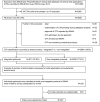Analysis of integrated clinical trial protocols in early phases of medicinal product development
- PMID: 28921395
- PMCID: PMC5684304
- DOI: 10.1007/s00228-017-2335-y
Analysis of integrated clinical trial protocols in early phases of medicinal product development
Abstract
Purpose: While in the past, most clinical trial applications (CTAs) following non-integrated (standard) protocols were used to investigate one primary objective concerning a (new) drug, nowadays, the use of integrated protocols investigating multiple objectives within the same CTA becomes more and more popular. The aims of the present study were to investigate the usage and the impact of integrated protocols on regulatory activities and to find the motivation for their increasing use.
Methods: Two thousand nine hundred sixty-nine phase I and I/II CTAs submitted to the German Federal Institute for Drugs and Medical Devices (BfArM) during the time period from August 1, 2004, until August 31, 2014, were analysed with regard to protocol and sponsor status, duration until initial authorisation and the number of substantial amendments and their respective approval times. Additionally, applicants who submitted integrated protocols to BfArM were interviewed with respect to their opinion on integrated protocols in an online survey.
Results: The percentage of integrated protocols has constantly increased by approximately 10% within the last 10 years from 17.9% in 2004 to 28.2% in 2014. It could be shown that authorisation procedures with single integrated protocols take significantly longer until initial authorisation (58 vs. 53 days) requires more substantial amendments (1.9 vs. 1.2 amendments per CTA) and the approval of the entirety of amendments takes longer to process as compared to standard protocols (22 vs. 14 days). Nevertheless, applicants prefer the use of integrated protocols due to higher time and cost economy for the entire phase I development process.
Conclusion: Although clinical trials (CTs) following integrated protocols are partly more time-consuming and costly, still, time and/or money may be saved during drug development due to the fact that overall, fewer CTs are needed than with standard protocols. Hence, the main reason for the increasing use of integrated protocols is improved time and cost efficiencies when conducting CTs.
Keywords: Early-phase clinical trials; Federal Institute for Drugs and Medical Devices (BfArM); Integrated protocol; Non-integrated (standard) protocol; Substantial amendment.
Conflict of interest statement
The authors declare that they have no conflict of interest.
Figures






References
-
- ICH Expert Working Group (1997) ICH harmonised tripartite guideline: general considerations for clinical trials E8. http://www.ich.org/fileadmin/Public_Web_Site/ICH_Products/Guidelines/Eff.... Accessed 05 Jun 2017
-
- National Health Service UK (2016) Clinical trials and medical research—phases of trials. http://www.nhs.uk/conditions/clinical-trials/Pages/Phasesoftrials.aspx. Accessed 05 Jun 2017
-
- National Institute of Health (2017) NIH clinical research trials and you—the basics. https://www.nih.gov/health-information/nih-clinical-research-trials-you/.... Accessed 05 Jun 2017
-
- Hasford J (2016) String protocols from phase I to approval? Original title: Kettenprotokolle von der phase I bis zur Zulassung? 24. BVMA-symposium, Munich 11/25/2016
-
- Applied Clinical Trials, Quintiles© (2009) Early-phase optimization stategies: model based testing and integrated protocols set the stage for phase III success. http://www.quintiles.com/%7E/media/library/media%20coverage/early-phase-.... Accessed 05 Jun 2017
MeSH terms
LinkOut - more resources
Full Text Sources
Other Literature Sources
Research Materials
Miscellaneous

